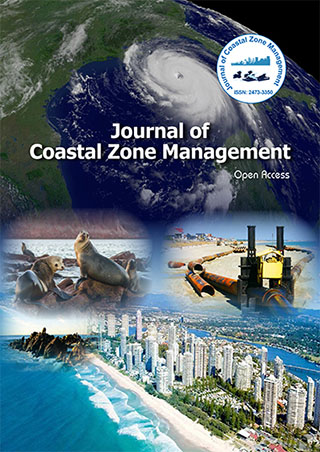Indexed In
- SafetyLit
- RefSeek
- Hamdard University
- EBSCO A-Z
- OCLC- WorldCat
- Publons
Useful Links
Share This Page
Journal Flyer

Open Access Journals
- Agri and Aquaculture
- Biochemistry
- Bioinformatics & Systems Biology
- Business & Management
- Chemistry
- Clinical Sciences
- Engineering
- Food & Nutrition
- General Science
- Genetics & Molecular Biology
- Immunology & Microbiology
- Medical Sciences
- Neuroscience & Psychology
- Nursing & Health Care
- Pharmaceutical Sciences
Opinion Article - (2024) Volume 27, Issue 6
The Function of Blue Carbon Ecosystems in Preventing Climate Change and Managing Coastal Regions
Blend Jaxer*Received: 28-Oct-2024, Manuscript No. JCZM-24-27581; Editor assigned: 30-Oct-2024, Pre QC No. JCZM-24-27581 (PQ); Reviewed: 15-Nov-2024, QC No. JCZM-24-27581; Revised: 22-Nov-2024, Manuscript No. JCZM-24-27581 (R); Published: 29-Nov-2024, DOI: 10.35248/2473-3350.24.27.653
Description
Blue carbon ecosystems, which include mangroves, salt marshes and seagrasses, lead a major role in climate change mitigation by acting as carbon sinks. These coastal ecosystems sequester and store large amounts of Carbon dioxide (CO2) from the atmosphere, helping to reduce the impacts of global warming. In addition to their climate benefits, blue carbon ecosystems provide numerous ecological services that are essential for the health of coastal zones. This article describes the role of blue carbon ecosystems in climate change mitigation and their importance in coastal zone management.
Blue carbon refers to the carbon stored in coastal and marine ecosystems, specifically in vegetation like mangroves, seagrasses and salt marshes. These ecosystems capture atmospheric CO2 through photosynthesis and store it in their biomass (roots, stems, leaves) and in the soil. Unlike terrestrial forests, blue carbon ecosystems can store carbon for long periods, sometimes for centuries, making them critical for long-term carbon sequestration.
Mangroves, for instance, are found in tropical and subtropical regions and are known for their ability to absorb large amounts of CO2. Seagrasses and salt marshes, found in both tropical and temperate regions, also serve as important carbon sinks. These ecosystems not only mitigate climate change but also provide habitat for a wide range of marine species.
The significance of blue carbon ecosystems to mitigate climate change lies in their ability to store carbon both above and below ground. When these ecosystems are left undisturbed, they can continue to sequester carbon for centuries, making them more effective than many land-based carbon sinks. For example, mangroves can store up to four times more carbon than tropical rainforests, mainly in the soil.
However, when blue carbon ecosystems are degraded or destroyed-through deforestation, coastal development, or pollution they release the stored carbon back into the atmosphere, contributing to global CO2 levels. This makes the preservation and restoration of these ecosystems critical in the fight against climate change. Protecting blue carbon ecosystems is not only essential for reducing emissions but also for maintaining their ability to store carbon.
In addition to their role in carbon sequestration, blue carbon ecosystems offer several co-benefits that make them valuable in coastal zone management. First, they act as natural barriers against coastal erosion and storm surges. Mangroves and salt marshes, in particular, help reduce the energy of incoming waves, protecting coastal communities from flooding and shoreline loss.
Finally, blue carbon ecosystems contribute to local economies through industries like fisheries and eco-tourism. Healthy mangroves, seagrasses and salt marshes can attract tourists and provide livelihoods for coastal communities, further underlining their importance.
Despite their value, blue carbon ecosystems are under threat from human activities. Coastal development, agriculture and aquaculture have led to the widespread destruction of mangroves, salt marshes and seagrasses. In addition, pollution from agricultural runoff and plastic waste degrades water quality, further harming these ecosystems.
Marine Protected Areas (MPAs) are also being established to safeguard blue carbon ecosystems from harmful activities, such as overfishing and coastal development. By creating zones where human impact is limited, MPAs help ensure the long-term health and resilience of these major ecosystems.
Blue carbon ecosystems are essential for both climate change mitigation and coastal zone management. Their ability to sequester large amounts of carbon, combined with their role in protecting coastal communities and supporting biodiversity, makes them invaluable assets in the fight against global warming. Protecting and restoring these ecosystems should be a priority for governments and organizations worldwide, as they offer a natural solution to climate change while providing numerous ecological and economic benefits.
Citation: Jaxer B (2024). The Function of Blue Carbon Ecosystems in Preventing Climate Change and Managing Coastal Regions. J Coast Zone Manag. 27:653.
Copyright: © 2024 Jaxer B. This is an open-access article distributed under the terms of the Creative Commons Attribution License, which permits unrestricted use, distribution, and reproduction in any medium, provided the original author and source are credited.
